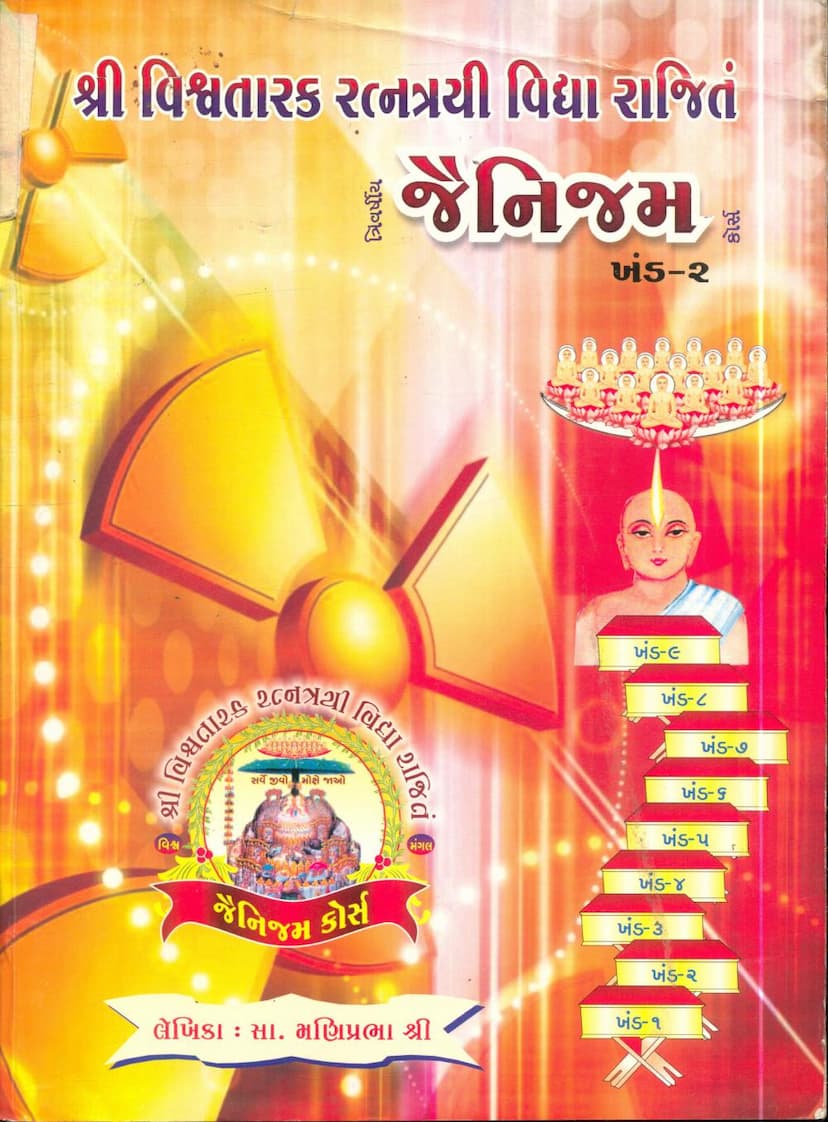Jainism Course Part 02
Added to library: September 2, 2025

Summary
This document is Book 2 of a three-year Jainism course, titled "Jainism Course Part 02," authored by Sa. Maniprabhashreeji. It is published by Adinath Rajendra Jain Shwetambara Pedhi and the catalog link is provided. The text is intended for private and personal use only.
The book aims to guide individuals towards spiritual upliftment and moksha (liberation) by imparting knowledge of Jain principles and practices. It emphasizes that while modern education builds grand structures, it often lacks the foundation of values and culture, which Jainism provides through its teachings. The course is designed to reach even remote villages where religious scholars might not have access, spreading the light of samyaktva (right faith) and guiding people towards true happiness.
The book is structured into five sections, each focusing on a different aspect of Jainism:
- Kriya Shuddhi (Purity of Action): Aimed at purifying one's life through righteous actions as prescribed by the Tirthankaras.
- Sukhi Parivar Ki Chabi (Key to a Happy Family): Focuses on creating a beautiful life akin to heaven and navigating the ocean of maitri (friendship).
- Sutra-Artha aur Kavya Vibhag (Sutra-Meaning and Poetry Section): Encourages memorizing meanings of scriptures and poetry to purify oneself through devotion.
- Adarsh Jeevan Charitra (Ideal Life Biographies): Encourages following in the footsteps of great souls to achieve immortality.
- Tattvajnan (Metaphysical Knowledge): Aims to teach concepts like the nature of the soul, Nava Tattva (Nine Essentials), and scriptures related to karma through engaging discussions.
The book contains detailed sections on various aspects of Jain philosophy and history, including:
- Jain History: Narratives about prominent figures and events in Jain history, such as King Samprati, Minister Vimalshah, Minister Tejpal, Bahad Mankhi, Bhima Kundalia, Queen Sulasa, Bhakta Jagad, minister Pethadshah, Samrat Siddhraj and Dandnayak Sajjan, and King Kunpal. These stories often highlight devotion, righteousness, and the consequences of one's actions.
- Tattvajnan (Metaphysical Knowledge): Explanations of the Jain cosmology, including the fourteen Rajlok (realms of existence), Adholok (lower realms), Urdhvalok (upper realms), the structure of the universe (Tilok), and the nature of celestial beings and hellish beings.
- Jainachar (Jain Conduct): Guidance on performing religious rituals correctly, the purpose and benefits of Samayika (a form of meditation and equanimity), and the proper use of devotional items.
- Devotional Songs and Prayers: Various hymns and verses in praise of Jain Tirthankaras and spiritual guides.
- Ethical Teachings: Emphasis on values like love, compassion, generosity, and the importance of not harming living beings, including the ethical treatment of animals.
- Practical Guidance: Advice on daily practices, such as the Pranidhan (resolve/intention) before performing any action, the significance of Samayika, Pratikraman (repentance), and Pauṣadh (a type of fasting).
- Cosmology and Astronomy: Detailed descriptions of the universe, including the Meru mountain, Jyotish Chakra (celestial cycles), and the different celestial abodes.
- Auspicious Events: Descriptions of the significance of Tirthankara's birth and the rituals associated with it.
- Moral Stories: Numerous illustrative stories that convey Jain principles and their practical application in life. The narrative of Dolly and Sameer, for instance, serves as a cautionary tale about the consequences of impulsive love and materialism versus the value of true relationships and spiritual well-being. The story of Moksha highlights the importance of adhering to religious practices and managing family relationships with compassion and understanding.
- Examination Material: The latter part of the book includes an open-book examination paper with questions designed to test the reader's understanding of the material covered.
The overall tone of the book is devotional, educational, and motivational, aiming to inspire readers to embrace Jainism and lead a life aligned with its principles for spiritual growth and ultimate liberation.